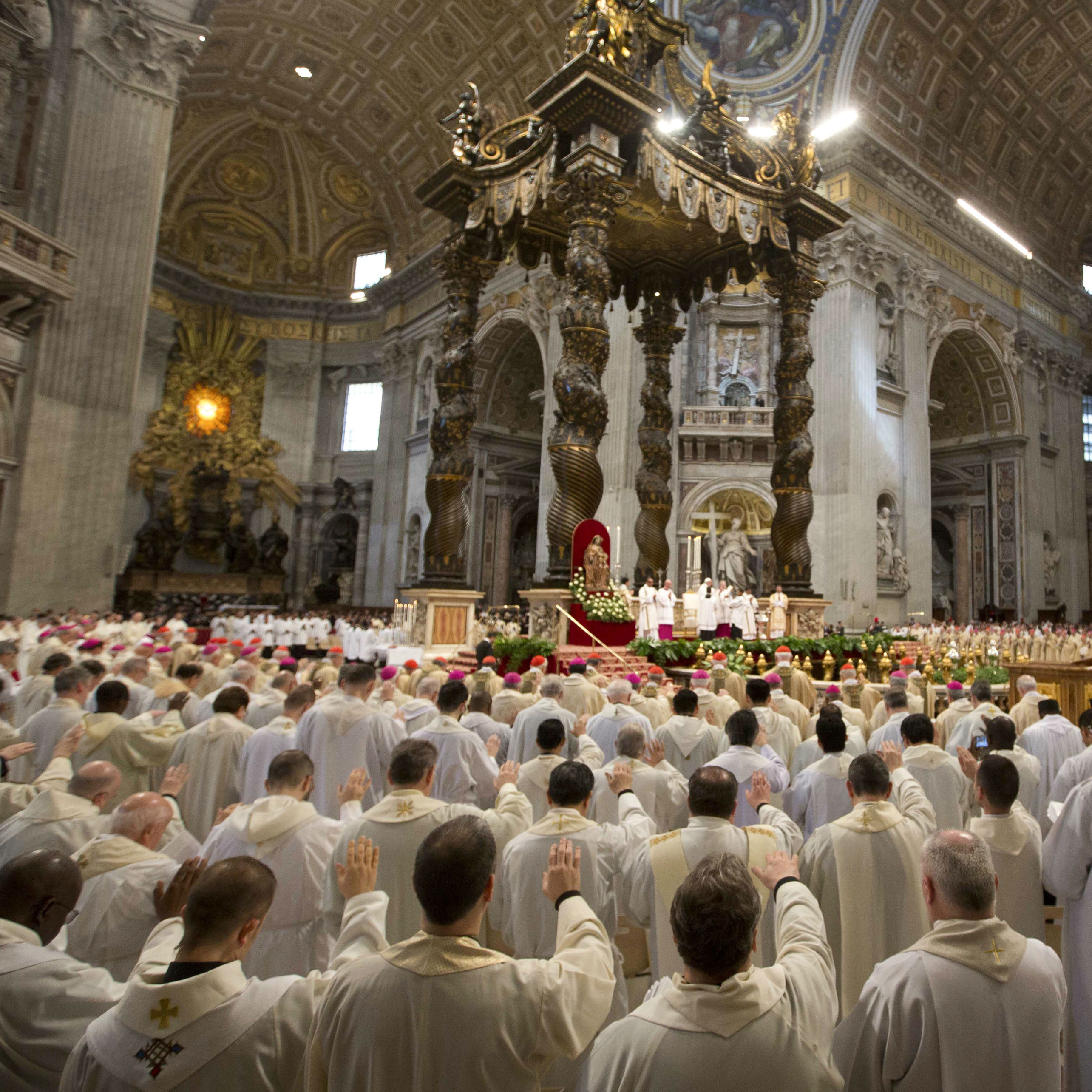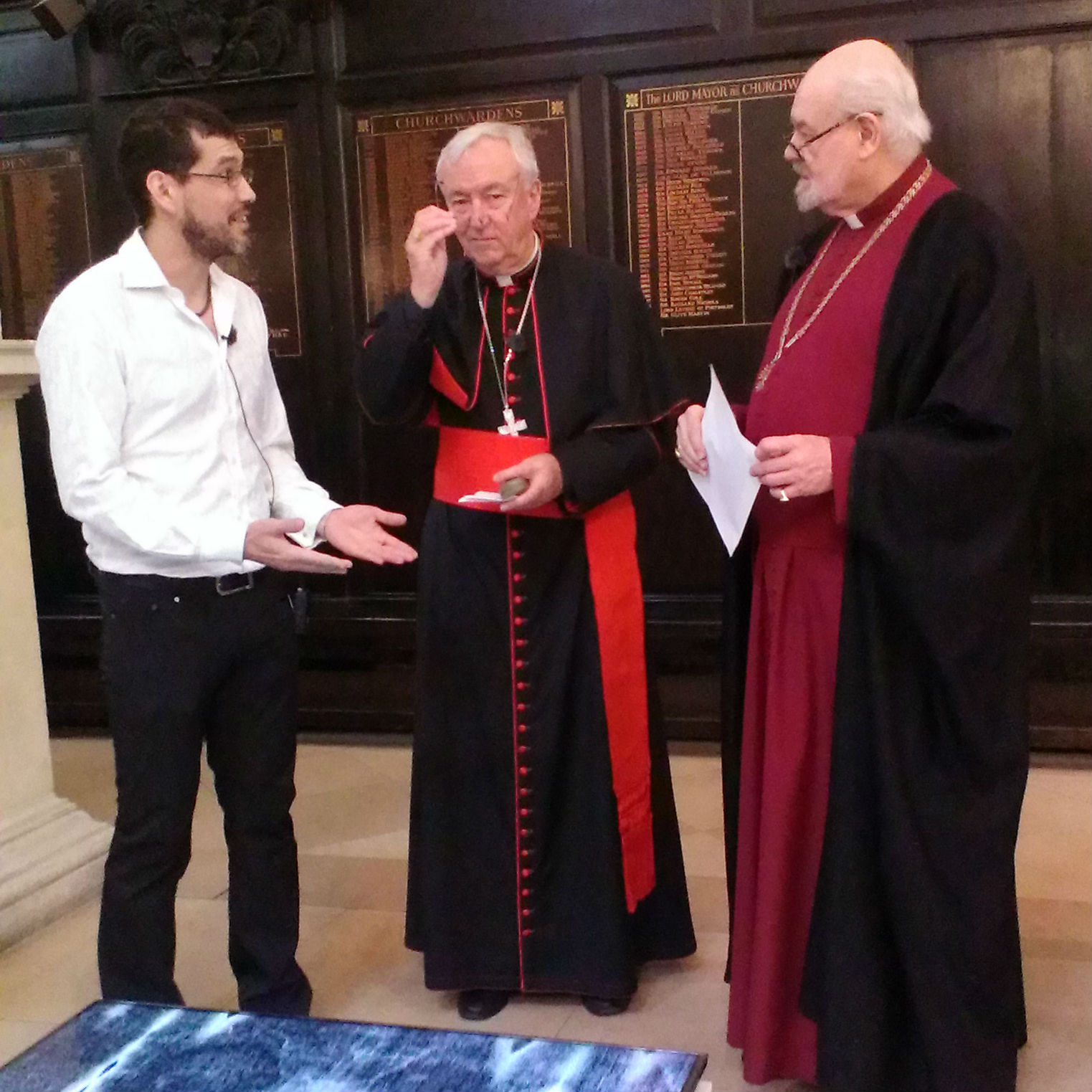Two leading churchmen made a pilgrimage yesterday to three unconventional Stations of the Cross in the City of London.
The Cardinal Archbishop of Westminster, Vincent Nichols, and the Anglican Bishop of London Richard Chartres, went on foot from Station to Station to meet the artists, read passages of Scripture and to lead prayers.
The artworks they visited are part of an exhibition held in 14 locations across London that tell the story of the Passion. It has been organised by Coexist House, a London-based organisation that seeks to promote interfaith understanding.
Among the 14 artworks are Old Masters and well-known artists like Eric Gill, whose Station 4 – Jesus Meets His Mother – is on the trail, as well as modern installations. The artists included Christians, Jews, Muslims and atheists.
The three Stations visited by Cardinal Nichols and Bishop Chartres are all contemporary installations and were chosen for the resonance they have with the current crisis concerning refugees fleeing war and persecution in the Middle East. At each Station there was a scripture reading, a conversation between the clerics and the artist, a prayer followed by a recital of the Lord’s Prayer.
First stop was at the Salvation Army’s steel and glass international headquarters in Queen Victoria Street. There in a corner of a busy downstairs café was Station 10 – Jesus is Stripped of His Garments. The installation by Turkish artist Güler Ates is a vast wall of baby clothes: babygros, t-shirts, trousers, dresses, all well worn and grubby.
Ates explained, as she rocked her own baby back and forth in her pram, that she had been inspired by the photograph of three year-old refugee baby Aylan Kurdi whose body was washed up on a beach at the Turkish resort of Bodrum, Turkey, last September. The artist said she had been pregnant when she first saw the picture and was intensely moved by it.
Refugee families helped stitch the baby clothes together and some had written words on them. Bishop Chartres’ eye was drawn to one in particular: “Why did my son have to die?”.
Reflecting on it Cardinal Nichols was moved to speak of refugee children’s suffering but also the wall of clothing led him to reflect on nakedness and the problem of sexting by young people. He said it was as though those who sent naked pictures of themselves to others were confused about their bodies and about what is appropriate. Our society, he said, needs to value the modesty and dignity of each person, especially that of children.
Next it was on to the early Wren church of St Stephen Walbrook and Station 13 – Jesus is taken down from the Cross. The image of Jesus here is that of a photographic negative showing a crucified man on the Turin Shroud. Life-sized and in glass it sits on a low slab.
At first that’s all the viewer sees but stop and linger for a while and people appear, crowds walking and faint images of individual faces. These indistinct images meld and merge with the image of Christ and his wounds, while haunting music plays on a loop.
There are also lines of writing covering the entire image: the names of the first 100,000 civilians killed in the civil war in Syria. The artist, Michael Magruder, related how he placed images showing the refugees travelling at Christ’s feet, Syrians helping one another at His hands and a series of faces at His face. Both Nichols and Chartres praised the sense of stillness and contemplation inspired by the work
Perhaps the most challenging Station on the pilgrimage was the ninth: Jesus Falls the Third Time. Constructed from industrial materials and placed outside, it has been placed beside the ancient church of St Giles Cripplegate. There in a windswept area surrounded by the concrete brutalism of the Barbican are stacks of oil drums – 14 in all – in varying shades of red.
In front of these is an enormous cross made of crash barriers. The artist G. Roland Biermann said he had thought first about the effect of drying blood, hence the colours of the oil drums and chosen to place them in 14 rows to represent all the Stations.
He referred to the ambivalence about oil as a material, its importance in the economy, its symbolism of material wealth and its connection with the Middle East and conflict. The crash barriers, Biermann continued, are usually designed to protect people travelling on motorways, but torn from this context and shaped as a cross are a memento mori.
Bishop Chartres said the work represented the brutality of the Cross against a geo-political background. He added that the location chosen for the installation – the historic site of the fort that was the headquarters for the Roman garrison in London – had extraordinary resonance. Cardinal Nichols spoke of the seeming precariousness of the towers of drums and the cross and linked to Christ’s third fall and the precariousness of our world. For him, the installation was “awesome”.
The pilgrimage ended with a few moments silence for victims of the terrorist attacks on Brussels.
Coexist House’s Stations of the Cross can be visited until 28 March (Easter Monday)




 Loading ...
Loading ...